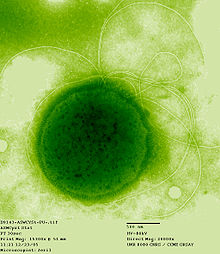| Thermococcus gammatolerans | |
|---|---|

| |
| Thermococcus gammatolerans | |
| Scientific classification | |
| Domain: | |
| Kingdom: | |
| Phylum: | |
| Class: | |
| Order: | |
| Family: | |
| Genus: | |
| Species: | T. gammatolerans
|
| Binomial name | |
| Thermococcus gammatolerans Jolivet, 2003
| |
Thermococcus gammatolerans is a gram-negative archaeon[1] extremophile and the most radiation-resistant organism known to exist.
As reported in 2003 the type strain EJ3T was taken from a submarine hydrothermal vent in the Guaymas Basin off the coast of Baja California at a depth of about 2,600 m by submersible Nautile during the 1991 Guaynaut cruise. Thermococcus gammatolerans thrives in temperatures between 55 and 95 °C with an optimum development around 88 °C.
Its optimal growth pH is 6, favoring the presence of sulfur (S), which is reduced to hydrogen sulfide (H
2S). It is the organism with the strongest known resistance to radiation, supporting a radiation of gamma rays from 30,000 gray (Gy).[2]
Along with the genera Palaeococcus and Pyrococcus, Thermococcus belongs to the Thermococcaceae family, sole family of the Thermococci (called "Protoarchaea" by Cavalier-Smith), a class in the phylum Euryarchaeota of Archaea.[3] Thermococcus species live in extremely hot environments such as hydrothermal vents with a growth optimum temperature above 80 °C. Thermococcus and Pyrococcus (literally "ball of fire") are both chemoorganotrophic anaerobic required. Thermococcus spp. prefer 70–95 °C, whereas Pyrococcus species prefer 70–100 °C.
The resistance to ionizing radiation of T. gammatolerans is enormous. While a dose of 5 Gy is sufficient to kill a human, and a dose of 60 Gy is able to kill all cells in a colony of E. coli, Thermococcus gammatolerans can withstand doses up to 30,000 Gy, and an instantaneous dose up to 5,000 Gy with no loss of viability.
- ^ Podstawka, Adam. "Thermococcus gammatolerans EJ3 | Type strain | DSM 15229, JCM 11827 | BacDiveID:16885". bacdive.dsmz.de. doi:10.13145/bacdive16885.20240510.9. Retrieved 2024-08-31.
- ^ Jolivet, E; L'Haridon, S; Corre, E; Forterre, P; Prieur, D (2003). "Thermococcus gammatolerans sp. nov., a hyperthermophilic archaeon from a deep-sea hydrothermal vent that resists ionizing radiation". Int. J. Syst. Evol. Microbiol. 53 (Pt 3): 847–51. doi:10.1099/ijs.0.02503-0. PMID 12807211.
- ^ Classification of phyla in LPSN; Parte, Aidan C.; Sardà Carbasse, Joaquim; Meier-Kolthoff, Jan P.; Reimer, Lorenz C.; Göker, Markus (1 November 2020). "List of Prokaryotic names with Standing in Nomenclature (LPSN) moves to the DSMZ". International Journal of Systematic and Evolutionary Microbiology. 70 (11): 5607–5612. doi:10.1099/ijsem.0.004332.